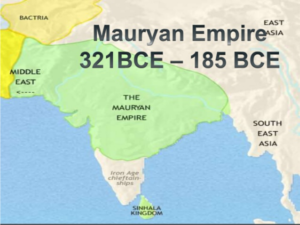THE MAURYAN EMPIRE (324-185 BC) – An introduction to the Mauryan Age
Get Insights about Mauryan Empire
The article tells us all about The Mauryan Empire- Its Inscriptions and Spread of material culture. Facts about Chandra GuptaMaurya, Ashoka and Bindusara are also dealt here.
Mauryan empire was one of the greatest empires to be established on the Indian soil, stretching from Oxus to delta of river Kaveri.
The Mauryan empire originated in the kingdom of Magadha in Indo-Gangetic plains with Patliputra as their seat of power.
Both classical and Indian sources suggest that alexander’s invasion of the north-west resulted in the establishment of Mauryan empire by Chandragupta, who overthrew Nanda dynasty with the help of Chanakya
Read more: Era of Rig Vedic Period: Important Highlights
Read more: United Nations & its Organizations- Key Insights

Inscriptions
- Epigraphical evidence is scanty for this period
- The most widely known are the edicts of Ashoka, which have been discovered from Mysore
- In his inscriptions Brahmi, Kharosthi, Prakrit, Aramaic and Greek languages had been used.
- Reconstruction of the Mauryan period to a great extent became possible only after the Brahmi script of the inscriptions at Sanchi was deciphered by James Princep in 1837 AD.
- Pillar edicts were mostly inscribed on well-polished sandstone monolithic pillars each surmounted with a finely sculpted animal capital involving great technological expertise in cutting and engraving and were largely confined to Ganges plain.
- Nagarjuni caves bear the inscriptions of Dasharatha the grandson of Ashoka.
- Barabar group caves contain four caves, three of these bear the Ashoka inscriptions. Names of these caves are- Karna chauper cave, Sudama cave and Lomasa rishi cave.
- These caves were donated to ajivika monks.
- Fourth cave contain the inscription of Maukhari king, Anatavarman.
Spread of material culture During Mauryan Rule
- Intensive use of iron
- Prevalence of writing
- Plenty of punch marked coins
- Abundance of beautiful pottery- northern black polished ware
- Socketed axes, sickles, ploughshare and spoked wheel
- Burnt wheels were used
- Ring wells first appeared under the Maurya’s
- Art of making steel have been spread through Maurya’s
Literary sources
- Brahmanical literature- puranas (Vishnu puran; describes the origin of Nandas)
- Buddhist literature- jataka stories pertain directly to the Mauryan period
- Divyadana and ashokvandana contain information about Bindusaraand Ashoka’s expedition to Taxila and his conversion to buddhism
- Dipavamsa and Mahavamsa describes influence of buddhism over ashoka and his role in spreading it to Ceylon
- Arthshastra by kautilya
- Mudrarakshasa by vishakhdatta
Chandra GuptaMaurya 324/321-297 BC
- Founder of Mauryandynasty by overthrowing nandas
- He was also known as palibrotham&sandrokotta
- Contemporary of alexander
- He liberated the north western India from the thraldom of SelucusNikator
- He spent his early life in Taxila
- It’s been mentioned in the Jain texts that he adopted Jainism and later went to Sravanbelgola with Bhadra bahu and committed selakhana (death by slow starvation)
Bindusara 297-273 BC
- Known by the name of Amitrochates(slayer of enemies) and Amitraghat (killer of enemies)
- He conquered the land between two sees- Arabian sea and Bay of Bengal
- Maintained diplomatic relations with western kings
- Believed to have joined the ajivika sect
Ashoka 268-232 BC
- After the death of Bindusara there was 4 years of war of succession among his sons and as per Buddhist texts Ashoka acquired the throne of Magadha after killing his 99 brothers.
- Ashoka literally means without sorrow
- He was the greatest Mauryan ruler and his other names are- Buddha Shakya, Dharmasoka, Devanampriya, Piyadassi etc.
- He was the viceroy of Ujjain and Taxila during the reign of Bindusara
- Mother of Ashoka was the daughter of a brahmana of Champa named Subhadrangi.
- Ashoka’s dhamma was inspired by the Buddhistupasaka dhamma.
- The main aim of dhamma was to preserve the social and intellectual order on the basis of tolerance.
- It ordained that people should obey their parents,pay respect to the brahmanas and Buddhists monks, and show mercy towards slaves and peasants.
- The basic attributes included- compassion,charity, truthfulness and gentleness.
For more information click here
For more such informative articles stay tuned to OWN TV.
